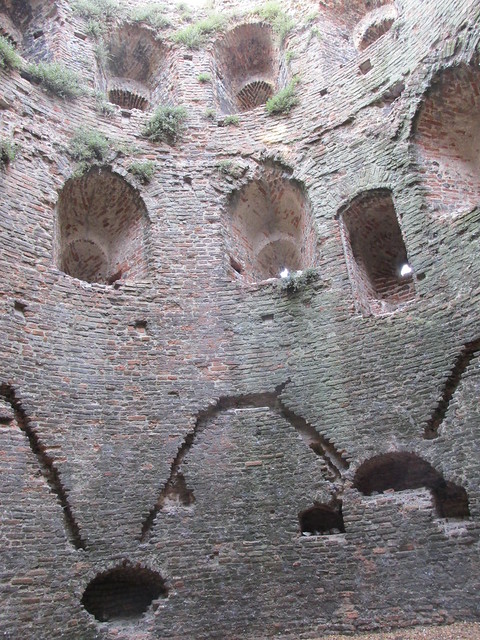The tower was built as an artillery blockhouse and is one of the earliest examples. It was constructed in 1398-9 to command a strategic point in the city's defences. At the time Britain wasn't very friendly with France. A French raid had devastated Southampton in 1338, and the Peasants' Revolt of 1381 had left Norwich badly damaged. So Cow Tower could serve a dual purpose to protect the city from attacks both inside and out! It would have housed a garrison when necessary.
Norwich was walled (mostly demolished to make way for expansion in the 18th and 19th centuries) and Cow Tower strengthened those defences. It was equipped with hand cannon and bombards (large caliber, muzzle-loading artillery pieces. Gives rise to the title of Bombadier.)
 |
| Cow Tower interior |
It had three floors, all now sadly missing, and a staircase up the side to reach them. It takes its name from the surrounding Cowholme area, meaning a water meadow where cows are grazed.
It's now a scheduled monument in the care of English Heritage. You can't go in, but you can see the interior clearly through the original (barred) doorway.
For a detailed review click here.


Interesting and nice of you to share.
ReplyDeleteI did go in here a few years ago Anne but had completely forgotten about it.
ReplyDeleteFascinating, I didn't know about the tower, must have been quite impressive in its heyday:)
ReplyDeleteI haven't been to Norwich for years - the last time was for my uncle's funeral in 2007. It looks as though it's time I paid it another visit, in spite of all the times I've been to Norfolk I've never spent much time in the city of Norwich itself and there's so much there to see.
ReplyDeleteI love Norfolk but I've never been to Norwich. It's good that these kinds of structures are preserved.
ReplyDeleteHow can something like this go "missing?" I am glad it has been "found" and can be admired for it's artistic and military qualities!
ReplyDelete